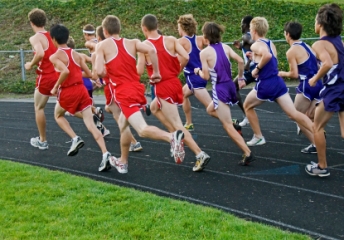Whether it is high school cross country, a local half marathon, or an ultra-competitive international triathlon, a running athlete's will is always put to the test. Smart science says that to improve long distance running the simple answer is to run more often. While this is true to an extent, ignoring the strength and stamina in particular muscle groups will decrease efficiency and increase risk for injury.

Hip muscles are important for runners, too
More explosive sports, like football or baseball, require great power and strength from the hips and lower back to generate force and speed. Similarly, soccer players require good endurance from the hip muscles as well as the ability to cut side to side. For long distance runners, who don't need to move laterally or explosively jump, hip muscles are often overlooked. Unlike baseball, soccer, and football, where some strengthening will occur as a byproduct of playing those sports, if a long-distance runner doesn't specifically train their hip muscles, they will not improve simply by running more.
Running 20, 30, or even more than 40 miles a week puts a great deal of stress on the body. As the legs tire, correct biomechanics tend to break down. Weak hip muscles, particular the gluteal musculature, will cause the knee to improperly move inwards and rotate. This increases straining across the knee joint, causing the lower back to tighten and the foot to flatten. Weak hip muscles thus increase the risk of injury to the runner's ankles, knees, and back while making each step less efficient than the one before.
Focus more on stamina, less on strength
The most important strength and conditioning concept for runners is to train muscles more for stamina than for strength. Being able to lift 300 pounds on a squat bar may be great for a football player but may not offer the same benefit for a long distance runner. Ideally, the hip musculature will be trained to help a runner maintain good pelvic stability throughout their run. This means co-training the core to reduce improper tilting, thus reducing risk of injury and improving overall performance.
Key Exercises
1. Side-lying Plank with Hip Abduction
- Lay on one side with the legs and body in a straight line.
- Plank onto the elbow, ideally with a pad or towel underneath to decrease irritation. WARNING: DO NOT PERFORM THIS EXERCISE IF YOU HAVE CHRONIC OR ACUTE SHOULDER PROBLEMS!
- While holding the planked position, lift the opposite leg towards the ceiling, ensuring that the leg does not drift forward. Focus on keeping everything in a relatively straight line.
- Completing repetitions of 20-50 is not uncommon to develop good endurance. Make sure to complete on both sides. 1-3 sets as tolerated as endurance improves.
2. In-Line Lunges with Dumbbells
- Complete a normal lunge but do so on a straight line, ensuring that each foot is not angled off the path.
- By adding dumbbells a runner can increase the amount of resistance but again, form and stamina are more important. Be sure to keep the back relatively straight and knee in line with toes.
- Bending over at the back and pushing the knee inward are signs of weakness in the pelvic region and should be focused on before adding any weight.
- Again, repetitions over 20 per set are ideal to encourage endurance.
3. Single Leg Squat.
- As will almost all sports, the single leg squat is key to athletic success. Completing this exercise with increased holds (10 seconds or more) helps not only strengthen the muscles but trains the body's proprioceptive system to promote overall balance.
- Complete 10 reps of 10 seconds holds and then switch sides.
- Ideally progress to holding single leg squat for 20-30 seconds.
- For runners, a full depth squat is not necessary but bending the knee between 20-45 degrees will help strengthen the hip appropriately. Make sure the knee does not go over the toes. This increases the stress along the patella, increasing risk of injury.
Remember, conditioning the hips for long-distance running depends greatly on the individual and volume of running. Completing exercises to "feel the burn" may be okay, but pushing through the pain is not wise. The purpose of building stamina with theses exercises is to increase overall endurance with running, not to make it difficult to walk the next day!
Posted January 22, 2013








